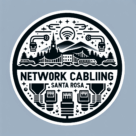What Are the 5 Networking Cable Categories? A Complete Beginner’s Guide
If you’ve ever wondered what type of cable connects your computer, router, or security camera to the internet, you’re not alone. Networking cables are the hidden backbone of every digital connection — from homes and offices to data centers.
In this guide, we’ll break down the five main categories of networking cables, what makes each one unique, and how to choose the right type for your network setup. Our expert network cabling technicians in Santa Rosa specialize in designing and installing structured cabling systems that meet every business need.
Understanding Networking Cable Categories
Networking cables, also known as Ethernet cables or twisted-pair cables, are used to transmit data between devices. Each category (or “Cat”) represents a specific performance standard set by the Telecommunications Industry Association (TIA).
The higher the category number, the faster the cable can transfer data and the better it performs at reducing signal interference.
The 5 Main Networking Cable Categories
1. CAT5 (Category 5)
CAT5 cables were once the standard for Ethernet networks. They can support data speeds up to 100 Mbps at a maximum distance of 100 meters.
- Best for: Basic home internet and small office networks
- Speed: Up to 100 Mbps
- Bandwidth: 100 MHz
- Notes: Mostly outdated and replaced by CAT5e or higher
While CAT5 was revolutionary in the 1990s, it’s now considered obsolete for modern high-speed connections.
2. CAT5e (Category 5e – Enhanced)
CAT5e improved on the original CAT5 by reducing crosstalk (signal interference) and supporting Gigabit Ethernet (1 Gbps).
- Best for: Home networks and small businesses
- Speed: Up to 1 Gbps
- Bandwidth: 100 MHz
- Notes: Still widely used due to its affordability and decent performance
CAT5e is perfect for typical household needs like streaming, gaming, and video conferencing.
3. CAT6 (Category 6)
CAT6 cables are designed for high-performance networks that handle large amounts of data. They can support speeds up to 10 Gbps over shorter distances (up to 55 meters) and 1 Gbps over 100 meters.
- Best for: Offices, commercial buildings, and smart homes
- Speed: Up to 10 Gbps (short distance)
- Bandwidth: 250 MHz
- Notes: Better insulation and shielding than CAT5e
CAT6 is the go-to choice for modern installations and provides a great balance between cost and performance.
4. CAT6a (Category 6 Augmented)
CAT6a is an advanced version of CAT6 that maintains 10 Gbps speeds up to the full 100 meters. It also features improved shielding, reducing interference in noisy environments.
- Best for: Data centers, enterprise networks, and future-proofing
- Speed: Up to 10 Gbps
- Bandwidth: 500 MHz
- Notes: Thicker cable; harder to install in tight spaces
For businesses or tech-savvy homeowners looking to stay ahead, CAT6a is a great investment. Once you understand the different categories, it’s helpful to know how to do network cabling properly to ensure stable connections.
5. CAT7 (Category 7)
CAT7 cables offer even greater shielding and performance, supporting 10 Gbps or higher speeds at frequencies up to 600 MHz. They use GG45 or Tera connectors instead of the standard RJ45.
- Best for: High-demand environments like server rooms and large offices
- Speed: 10 Gbps+
- Bandwidth: 600 MHz
- Notes: More expensive and not always necessary for standard networks
CAT7 is primarily used in specialized or enterprise setups where maximum performance is required.
Bonus: CAT8 – The Next Generation
While not part of the original five categories, CAT8 is worth mentioning. It supports 25 Gbps and 40 Gbps speeds over short distances (up to 30 meters) and is ideal for data centers or advanced networking environments.
As technology evolves, CAT8 represents the next leap forward in cabling performance.
How to Choose the Right Cable for Your Needs
Choosing the right Ethernet cable depends on your setup:
- Home users: CAT5e or CAT6 offers great value and speed.
- Small businesses: CAT6 or CAT6a ensures better performance and longevity.
- Large organizations or data centers: CAT6a, CAT7, or CAT8 for top-tier speeds and minimal interference.
When in doubt, go for CAT6 or higher to keep your network fast and future-ready.
Tips for Installing Networking Cables
If you’re planning a new installation, keep these best practices in mind:
- Hire a certified network cabling installer to ensure quality and code compliance.
- Avoid running cables parallel to electrical lines to prevent interference.
- Label and test every connection.
- Plan extra cabling capacity for future expansion.
Proper installation ensures maximum performance and reliability for years to come.
Final Thoughts
Networking cables may seem simple, but they play a crucial role in keeping your digital world connected. Understanding the five main categories — CAT5, CAT5e, CAT6, CAT6a, and CAT7 — helps you choose the right one for your speed, distance, and budget needs. If you’re setting up cables in outdoor or humid environments, you might wonder whether LAN cables are waterproof.
Whether you’re setting up a home office or upgrading a corporate network, investing in the right Ethernet cable ensures your system runs faster, cleaner, and more reliably.
